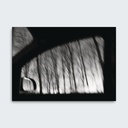Anniek Snoeijs. BLOOM
| Language: English |
| Cover: Paperback |
Description:
"Sexual transgressive behavior is a major social problem anywhere in the world and one that is terribly taboo. I
had to deal with such a traumatic experience myself. For 7seven years I did not
dare to talk about it. Through making this book, I managed to talk about this experience more easily.
'Bloom' contains photos of my own healing process. The
pictures show the feelings I was dealing with throughout the process. The
dark photos represent the somber and difficult moments and the light
photos represent hope and healing.
My book also shows 11 portraits of women who had to deal
with
sexual transgressive behavior. Some of the women wanted to share
their stories
in the book. The unidentifiable portraits depict the taboo surrounding
this subject as where the plain portraits show strength and
courage. All the women who participated in this project played an
incredibly important role in my healing process. Because of this, I have
found hope and strength again."
Anniek Snoeijs
245 x 330 mm
ISBN:
9789464002065
Specifications:
240 pages













